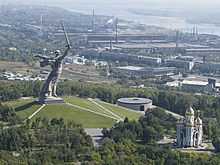The Motherland Calls
| The Motherland Calls | |
|---|---|
| Soviet Union / Commonwealth of Independent States | |
|
The Motherland Calls in Volgograd | |
| For heroes of the Battle of Stalingrad | |
| Unveiled | 15 October 1967 |
| Location |
48°44′32.5″N 44°32′13″E / 48.742361°N 44.53694°E near Mamayev Kurgan, Volgograd |
| Designed by | Yevgeny Vuchetich, Nikolai Nikitin |
The Motherland Calls (Russian: Родина-мать зовёт! Rodina-Mat' zovyot!), also called Homeland-Mother, Homeland-Mother Is Calling, simply The Motherland, or The Mamayev Monument, is a statue in Mamayev Kurgan in Volgograd, Russia, commemorating the Battle of Stalingrad. It was designed by sculptor Yevgeny Vuchetich and structural engineer Nikolai Nikitin, and declared the largest statue in the world in 1967. Compared with the later higher statues, The Motherland Calls is significantly more complex from an engineering point of view, due to its characteristic posture with a sword raised high in the right hand and the left hand extended in a calling gesture. The technology behind the statue is based on a combination of prestressed concrete with wire ropes structure, a solution which can be found also in another work of Nikitin's, the super-tall Ostankino Tower in Moscow. It is the tallest non-religious statue of a woman in the world.
Construction and dedication
When the memorial was dedicated in 1967 it was the tallest sculpture in the world, measuring 87 metres (279 feet) from the tip of its sword to the top of the plinth. The figure itself measures 52 metres (170 feet), and the sword 33 metres (108 feet). Two hundred steps, symbolizing the 200 days of the Battle of Stalingrad, led from the bottom of the hill to the monument. The lead sculptor was Yevgeny Vuchetich, and the significant structural engineering challenges of the 7,900 tonnes (7,800 long tons; 8,700 short tons) of concrete[1] sculpture were handled by Nikolai Nikitin. The statue appears on both the current flag and coat of arms of Volgograd Oblast.
Sculpture model and inspiration
The model who posed for the statue, Valentina Izotova, a native of the city, is still recognized for her resemblance to the statue. She was recruited by Lev Maistrenko, an artist who was working on the memorial complex in the early 1960s.
According to some sources the statue was partially inspired by the Winged Victory of Samothrace, with somewhat more extended drapery.
Marshal of the Soviet Union Vasily Ivanovich Chuikov is buried in the area of the monument, as is famous Soviet sniper Vasily Zaytsev, who killed 225 Axis soldiers in the battle of Stalingrad.
Structural problems
The statue is claimed to be leaning due to changes in groundwater level causing movement of the foundations. The lean is rapidly getting worse.[1] The statue is not fixed to its foundations and is held in place only by its weight. It has shifted 20 centimetres and is not expected to be able to move much farther without collapsing. While local authorities deny that the statue is in danger, conservation and restoration work started in 2010.[2]
See also
- Socialist realism
- Mother Motherland, name for any of several huge statues in various cities of the former Soviet Union
- Worker and Kolkhoz Woman
- List of statues by height
Further reading
.svg.png)
1. Spring Temple Buddha 153 m (incl. 25 m pedestal and 20 m throne)
2. Statue of Liberty 93 m (incl. 47 m pedestal)
3. The Motherland Calls 91 m (excl. plinth)
4. Christ the Redeemer 38 m (incl. 8 m pedestal)
5. Statue of David 5.17 m (excl. 2.5 m plinth)
Scott W. Palmer, "How Memory was Made: The Construction of the Memorial to the Heroes of the Battle of Stalingrad", The Russian Review 68:3 (July 2009), 373-407.
Notes
External links
| Wikimedia Commons has media related to The Motherland Calls. |
- Google Maps Satellite view of statue in Volgograd
- The Motherland Calls: Russia's symbol of victory (23 minute RT documentary)
- YouTube video of Родина-мать зовёт! ("Rodina Mat' Zovyot!")
- View from the top and inside
| Records | ||
|---|---|---|
| Preceded by Tokyo Wan Kannon 56 m (183.7 ft) |
World's tallest statue 1967 –1989 |
Succeeded by Dai Kannon of Kita no Miyako park 88 m (289 ft) |
Coordinates: 48°44′32.5″N 44°32′13″E / 48.742361°N 44.53694°E
